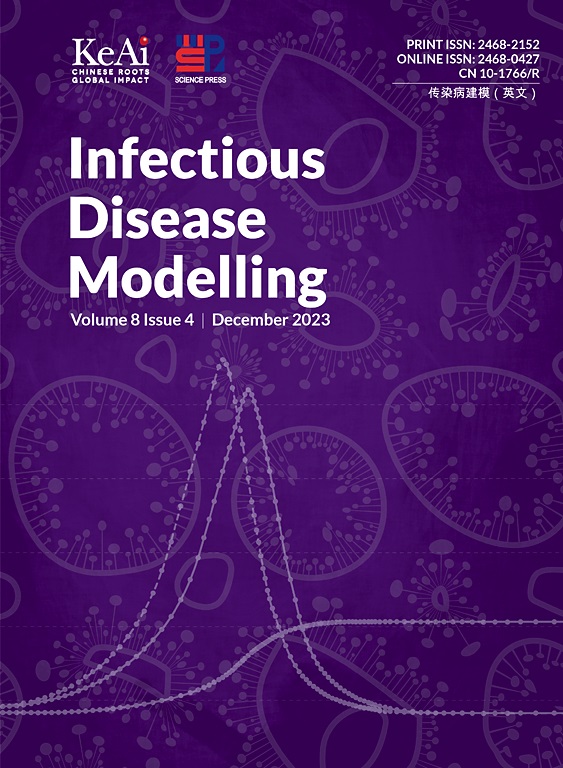Interventions for SARS-CoV-2 prevention among Jailed adults: A network-based modeling analysis
IF 2.5
3区 医学
Q1 Medicine
引用次数: 0
Abstract
Background
Airborne pathogens present challenges in settings like jails or prisons with a high density of contacts. The state of Georgia has the highest percentage of its citizens under correctional supervision in the United States. Yet, it had slow COVID vaccine uptake among jail residents, requiring prevention also using non-pharmaceutical interventions. Using a network-based SARS-CoV-2 transmission model parameterized with data from the Fulton County Jail, this study investigates the impact of three SARS-CoV-2 prevention strategies: vaccination, contact tracing and quarantining, and jail release to reduce jail population density.
Methods
Social contact networks were simulated at two different overlapping network layers: cell and block. Cell-level contacts represented shared confined sleeping space, whereas block-level contacts represented shared socialization space. Contact tracing and quarantining were simulated at the cell-level or both cell- and block-levels, hereafter referred to as all-level. A reference scenario and nine intervention scenarios were simulated three hundred times to estimate the median and interquartile range (IQR) of the outcome measures. Each scenario simulated a 185-day period to measure the prolonged effects of the interventions amid a potential COVID outbreak in the jail. The cumulative incidence, number of infections averted (NIA), and percentage of infections averted (PIA) were calculated comparing interventions against a base scenario without them. For the seven scenarios involving contact tracing and quarantining, total quarantines over the simulation and the number of quarantines per day were calculated to determine the quarantine requirements. Sensitivity analyses compared the impact of jointly varying vaccination rates and contact tracing rates.
Results
Cell-level contact tracing alone was an ineffective intervention (3.2% PIA), but its impact increased in combination with other interventions (i.e., vaccination or increased jail release rate). The other intervention strategies each produced a PIA over 10%, with the jail release scenario producing a PIA of nearly 20% despite only resulting in a 13% reduction in the jail population. The all-level contact tracing only scenario was effective at both 50% and 100% of contacts traced, but feasibility would be limited without a reduction in the jail population.
Conclusions
Implementing a combination intervention approach could substantially reduce the morbidity from COVID-19 and future respiratory viruses in this jail setting while providing secondary protection to the community.
监禁成人预防SARS-CoV-2干预措施:基于网络的建模分析
背景:空气传播的病原体在监狱等接触密度高的环境中构成挑战。在美国,乔治亚州受惩教监督的公民比例最高。然而,监狱居民对COVID疫苗的吸收缓慢,需要使用非药物干预措施进行预防。利用基于网络的SARS-CoV-2传播模型,以Fulton县监狱的数据为参数化,研究了三种SARS-CoV-2预防策略:疫苗接种、接触者追踪和隔离以及释放囚犯对降低监狱人口密度的影响。方法在细胞和块两个不同的重叠网络层上模拟社会接触网络。细胞级接触代表共享的受限睡眠空间,而块级接触代表共享的社交空间。在细胞级或细胞级和块级(以下称为全级)模拟接触者追踪和隔离。模拟一个参考情景和九个干预情景300次,以估计结果测量的中位数和四分位数范围(IQR)。每个场景都模拟了185天的时间,以衡量在监狱可能爆发COVID时干预措施的长期影响。计算了累计发病率、避免感染数(NIA)和避免感染百分比(PIA),将干预措施与不采取干预措施的基本情况进行比较。对于涉及接触者追踪和隔离的七个场景,将计算模拟期间的总隔离次数和每天的隔离次数,以确定隔离要求。敏感性分析比较了联合改变疫苗接种率和接触者追踪率的影响。结果细胞水平的接触者追踪是一种无效的干预措施(3.2% PIA),但与其他干预措施(如接种疫苗或增加监狱释放率)联合使用,其效果会增强。其他干预策略均产生了超过10%的PIA,其中监狱释放方案产生了近20%的PIA,尽管只导致监狱人口减少了13%。仅追踪所有级别接触者的方案对追踪的接触者的50%和100%都有效,但如果不减少监狱人口,可行性将受到限制。结论实施联合干预措施可显著降低该监狱环境中COVID-19和未来呼吸道病毒的发病率,同时为社区提供二级保护。
本文章由计算机程序翻译,如有差异,请以英文原文为准。
求助全文
约1分钟内获得全文
求助全文
来源期刊

Infectious Disease Modelling
Mathematics-Applied Mathematics
CiteScore
17.00
自引率
3.40%
发文量
73
审稿时长
17 weeks
期刊介绍:
Infectious Disease Modelling is an open access journal that undergoes peer-review. Its main objective is to facilitate research that combines mathematical modelling, retrieval and analysis of infection disease data, and public health decision support. The journal actively encourages original research that improves this interface, as well as review articles that highlight innovative methodologies relevant to data collection, informatics, and policy making in the field of public health.
 求助内容:
求助内容: 应助结果提醒方式:
应助结果提醒方式:


